
The Anthomyiidae are a large and diverse family of Muscoidea flies. Most look rather like small houseflies, but are commonly drab grey. The genus Anthomyia, in contrast, is generally conspicuously patterned in black-and-white or black-and-silvery-grey. Most are difficult to identify, apart from a few groups such as the kelp flies that are conspicuous on beaches.

The Lonchaeidae are a family of acalyptrate flies commonly known as lance flies. About 500 described species are placed into 9 genera. These are generally small but robustly built flies with blue-black or metallic bodies. They are found, mainly in wooded areas, throughout the world with the exception of polar regions and New Zealand.

Ischnura aurora, golden dartlet, also known as the aurora bluetail, is a species of damselfly in the family Coenagrionidae.

Mocis frugalis, the sugarcane looper, is a moth of the family Erebidae. The species was first described by Johan Christian Fabricius in 1775. It is found in several parts of the world, including India, Sri Lanka, West African countries and other Oriental regions. The adult is a fruit piercer and a major pest of crops.
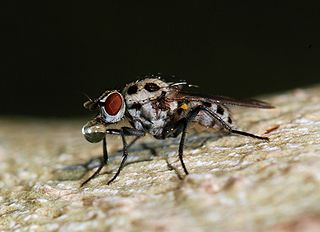
Anthomyia is a genus of flies in the family Anthomyiidae. They look rather like small houseflies, but commonly have conspicuous black-and-white patterning. This appears to be a mild form of aposematic coloration, though they do not appear to be distasteful unless they have eaten something offensive to the predator and have loaded their guts with it.
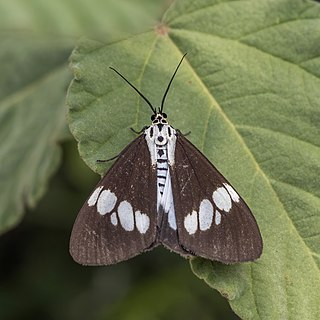
Nyctemera lacticinia, the common nyctemera, is a moth of the family Erebidae. The species was first described by Augustus Radcliffe Grote in 1873. It is found in Japan, from the Oriental tropics of India, Sri Lanka, Myanmar to Taiwan, Peninsular Malaysia and Borneo.
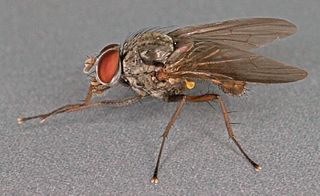
Pegomya winthemi is a species of fly in the family Anthomyiidae. Found in North America, it was first described as Anthomyia winthemi in 1829 by Johann Wilhelm Meigen. The insect measures 4.25–5 mm long. Its pedipalps are infuscated apically; the anterior lateral angles of the thorax and scutellum are yellowish red. The longest hairs of the arista are a little longer than its basal diameter, while the lower calyptra are distinctly protruded. The scutellum is almost bare on the disc. The posthumeral bristle is not duplicated, and the area between the posthumeral and the margin of thorax is almost bare.
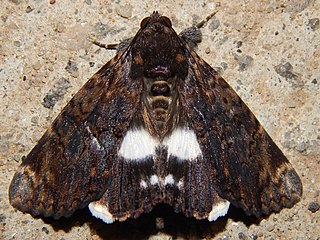
Nagia linteola is a species of moth in the family Erebidae first described by Achille Guenée in 1852. This species occurs in South Africa, the Democratic Republic of the Congo, Yemen, the Comoros, Mauritius, Madagascar, Indonesia (Borneo), India, Sri Lanka, Myanmar, Thailand and in Australia, where it has been recorded from Western Australia, the Northern Territory, Queensland and Victoria.

Poecilotheria vittata, sometimes called Pederson's ornamental, the ghost ornamental, or magam tiger spider, is an arboreal tarantula. It is endemic to Sri Lanka. In IUCN Red List, the species is cited as a synonym of Indian species Poecilotheria striata, but in other local text books and online publications, it is cited as a separate species. As of February 2016, the species was considered to be native to both India and Sri Lanka by the World Spider Catalog.
Anthomyia obscuripennis is a species of fly in the family Anthomyiidae. It is found in the United States.
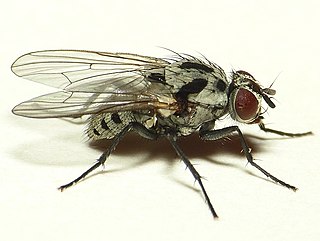
Anthomyia procellaris is a species of fly in the family Anthomyiidae.
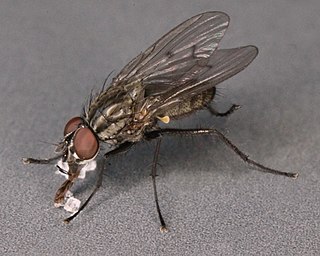
Anthomyia confusanea is a species of fly in the family Anthomyiidae. It is found in the Palearctic.

Anthomyia bazini is a species of fly in the family Anthomyiidae. It is found in the Palearctic. For identification see:
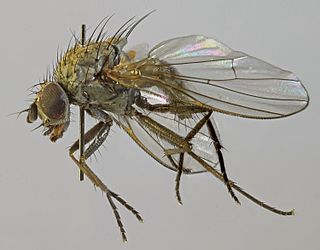
Azelia cilipes is a species of fly in the family Muscidae. It is found in the Palearctic.
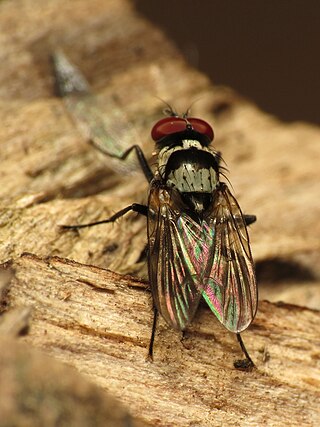
Anthomyia oculifera is a species of root-maggot fly in the family Anthomyiidae.
Anthomyia ochripes is a species of root-maggot fly in the family Anthomyiidae.
Anthomyia mimetica is a species of root-maggot fly in the family Anthomyiidae. It is found in Europe.

Blera humeralis, the Yellow-legged wood fly, is an uncommon species of syrphid fly officially described by Samuel Wendell Williston in 1882. Hoverflies are so-named for the ability to remain nearly motionless while in flight. The adults are known as flower flies, as they are commonly found around and on flowers from which they get energy-giving nectar and protein-rich pollen. The larvae are of the rat-tailed type, feeding on exuding sap or in the rot holes of trees.
Anthomyia cannabina is a species of fly in the family Anthomyiidae. It is found in the Palearctic. Identification of Anthomyia cannabina is described in Bei-Bienko & Steyskal 1988.

Anthomyia monilis is a species of fly in the family Anthomyiidae. It is found in the Palearctic.
















